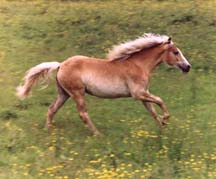Haflinger
N/A
Tue, 26th November, 2024 - 8:15 pm GMT
Sponsor Ads:

Alternative Name
N/ABasic Info
Haflingers are chestnut in color from a rich golden chestnut to a chocolate with a light colored mane and tail which range from white to flaxen in color. They stand between 13.2 (138 cm) and 14.3 hands (150 cm). The horse's appearance should be elegant and harmonious, with a refined and expressive head with large eyes, a well shaped mid-section, and a well-shaped croup which must not be too steep or too short. The horse should be well muscled and show correct, clean limbs with well formed clearly defined joints. Breeding stallions should have unmistakable masculine features and brood mares should exhibit undeniable feminine lines and features. The head should be noble and lean and should fit well with the rest of the horse. The eyes should be large and positioned forward. The nostrils should be large and wide. Should have a light poll and correctly positioned ears. The neck is of of medium length and should become narrower towards the head. There should be sufficient freedom through the jowls. The legs should show clear, lean distinct joints, and equal stance on all four feet. Legs should be in a straight line when viewed front or back. From the side the front legs should be straight and hind legs should display an angle of 150 degrees through the hock and an angle of 45-50 degrees through the pastern and hoof to the ground. The knee should be broad and flat and the hocks wide and powerful. Pasterns should be long and well developed and the hooves should be round, distinct and hard.
Health
N/AHabitat
N/ABehavior
The Haflinger has diligent, rhythmic and ground covering gaits. The walk is relaxed, energetic, and proud and cadenced. The trot and canter are elastic, energetic, athletic, and cadenced with natural self-carriage and off the forehand as well as balanced with a distinct moment of suspension. The hindquarters should work actively with lots of propulsion. This propulsion should transfer through the elastic back to the free moving shoulder and front legs. A little knee action is desired. Especially the canter should have a very distinct forward-upward motion.Origin
AustriaHistory
The history of the Haflinger horse can be traced to medieval times when writings told of an Oriental race of horse found in the Southern Tyrolean Mountains of present day Austria and northern Italy. Many of the villages and farms in the Tyrol were accessible only by narrow paths requiring agile and sure-footed horses for transportation and packing. Artwork from the region from the early 1800's depicts a small noble chestnut horse with packs and riders traversing steep mountain trails. The first official documentation of the present day Haflinger (named for the Tyrolean village of Hafling) was in 1874 when the foundation stallion 249 Folie was born of the half-Arab stallion 133 El' Bedavi XXII crossed with a refined native Tyrolean mare. All modern purebred Haflingers must trace their ancestry directly to Folie through seven different stallion lines: A, B, M, N, S, ST, and W. During the years of World War II, there was a significant shift in breeding practices, as pack horses were needed by the military and a shorter draftier Haflinger fit the bill. Following the war, the height and refinement of the breed has returned, with an emphasis on developing a small horse that was versatile for both riding and driving, with a strong constitution, a solid conformation with substantial bone, and an uncomplicated personality. The uniqueness of the Haflinger lies, of course, in its golden chestnut coloring and long flowing white mane and tail. But more unique is the people-loving, willing and forgiving temperament that was established over centuries of living alongside and working with the mountain peasants, serving all purposes for all family members. Haflingers very simply became part of the family. The majority of Haflingers are still imported from Austria even today. State studs own the stallions in Austria, carefully maintaining the quality of the breed. The first Haflingers arrive in the United States in 1958 when Tempel Smith of Tempel Farm, Wadsworth, Illinois imported them from Austria to begin a breeding program along with his imported Lipizzan horses. The modern Haflinger is now found all over the world, active in such varied uses as draft work, packing, light harness and combined driving, western and trail riding, endurance riding, dressage and jumping, vaulting and therapeutic riding programs. Haflingers hold their own in competition with other breeds, often showing surprising athleticism and strength for their size.Common Foods
grassSponsor Ads:
Be kind, for everyone you meet is fighting a hard battle. -- Plato
Haflinger
Coded by: BGID® | ALL RIGHTS RESERVED Copyright © 2000-2024
Disclaimer | Privacy | Report Errors / Contact | Credits










